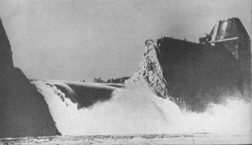 Avro
Lancaster Heavy Bomber
Avro
Lancaster Heavy Bomber

During the WW II, a British aeronautical engineer, Barnes Wallis came up with an idea of a barrel shaped bomb released with a back spin to attack German dams. It would bounce on the water and skip over the torpedo net protecting the dam. Following is excerpted from a book called "The Dam Busters" by P. Brickhill (now out of print.)
"If you make something spin fast enough around an axis it needs a
surprising amount of force to tilt it off that axis. The earth is one
example of spinning on an axis. It stays on that same axis (thank God)
but it doesn't have to be a sphere. A lot of youngsters have little gyro-
scopes as toys. Yank hard on a string and a caged disc spins like mad,
and people are intrigued at the strength it needs to budge it from its
axis. Or take a child's top. It stays upright when it is sp;nning fast
enough and falls over when it isn't. (That's a top secret!). A lot of
aircraft blind flying instruments depend on gyroscopic action, such as
an artificial horizon.
Wallis knew that he had to reduce the diameter of his missile. And
he knew it still had to hit the water on every bounce with the same
shape surface as before. He already knew his missile had to drop with
a lot of back-spin on it to control the bounces, and also to make it
crawl underwater flat against the dam wall when it hit. So why not a
missile shaped like a portly barrel with enough back-spin to keep it
gyroscopically on an identical axis all the way.
That would reduce the diameter without lengthening the 'barrel'
shape too much. It seemed all so easy. All one had to do was think it
out first.
His assistants carved on lathes a series of fat, barrel-shaped models,
each with differing weight-size-shape ratios and all of them with a
potential diameter small enough to be carried under a Lancaster.
Wallis tested each repeatedly with varying combinations of back-
spin, catapult velocity and height. Consistently they skipped across the
water in the tank in little flashes of spray but seldom tilting off their
horizontal axis, presenting at each skip the same pot-bellied shape to
the water. By trial and error he found at what speeds each model would
slither against the far end of the tank and crawl under the water
hugging the wall (with the residual back-spin). He filled a notebook with
details of each shape, and by simple elimination was able to choose the
model with the widest range of reliable performance.
The rest was largely doing sums, such as how fast a five ton 'barrel'
could be safely spun backwards before release from an aircraft and
achieve enough gyroscopic stability for half a mile or more of bouncing
bumps. Wallis made it between 450-500 revolutions per minute
backwards.
By the middle of 1942 he was satisfied he could make a five tonner
do what he wanted it to. The only thing he didn't know was whether
to call it a barrel, a bomb, a mine or a missile. Not that it mattered."
 Avro
Lancaster Heavy Bomber
Avro
Lancaster Heavy Bomber
Taerum flicked the belly lights on and, peering down
from the blister, started droning: 'Down . . . down . . . down . . . up a bit
... steady, stead-y-y.' The lights were touching each other, 'G George'
was exactly at 60 feet and the flak gunners had seen the lights. The
streams of glowing shells were swivelling and lowering, and then the
shell were whipping towards them, seeming to move slowly at first like
all flak, and then rushing madly at their eyes as the aircraft plunged
into them.
Gibson said tersely: 'Bomb on! '
Spafford flicked the switch and heard the whine of the electric
motor starting back in the fuselage. He could hear it winding up speed
and a vibration grew through the aircraft as the black barrel under-
neath stirred out of its inertia and started revolving backwards, faster
and faster, building up to optimum revs., until G George was thrum-
ming like a live thing.
Gibson held her steady, pointing between the towers.
Spafford screamed, 'Bomb gone!' loud and sharp, and they rocketed over the dam between the towers.
 Moehne
dam after the raid
Moehne
dam after the raid
In a few moments the mountain of water erupted skyward again
under the dam wall. It was uncanny how accurate the bomb was. The
spray from the explosions was misting up the whole valley now and it
was hard to see what was happening by the dam. ---
'Hell, it's gonel It's gonel Look at it for Christ's sakel' Wheeling
round the valley side Martin had seen the concrete face abruptly split
and crumble under the weight of water. Gibson swung in close and was
staggered. A ragged hole 100 yards across and 100 feet deep split the
dam and the lake was pouring out of it, 134 million tons of water
crashing into the valley in a jet 200 feet long, smooth on top, foaming at
the sides where it tore at the rough edges of the breach and boiling over
the scarred earth where the power house had been."
"The Dam Busters" by P. Brickhill